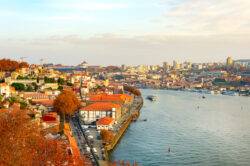Things are cooler and, in many ways, more enjoyable (Picture: Getty Images)
I must admit that when it was first suggested to me that I might enjoy Portugal in the cooler months, I did a little shiver. After all, my dream holiday weather includes scorching 36-degree sunrays.
However, after I’d packed up my suitcase – and any ideas of lounging on a sunbed – and headed to the airport, I soon discovered that there really are some pretty cool benefits to visiting Portugal during the milder seasons.
Plus, with tourist bookings for the New Year in Portugal forecasted to break records, according to the Association of Travel and Tourism Agencies – it’s clear you don’t have to visit during peak season.
On arrival, the locals were quick to tell me that a trip this is often best when the weather is more comfortable. And it makes sense, as it’s far easier to do a bit of touristing when life is less sweaty.
And Portugal is full of things to do whatever the weather. From wine tasting tours and gourmet seafood, to rooftop pools (yes, I did get my sunbed!) and pastel de nata cooking classes, there really wasn’t a dull moment. And even when you did get a second to stop and take stock, you couldn’t escape the breathtaking views on offer.
So if you’re thinking of exploring Portugal away from the summer sun (and even if you want to do it in high season), there are two places you should definitely explore.
First up, Porto…
Although I had previously been to Portugal, Porto was uncharted territory for me. Besides its reputation for producing the finest Port, I had no idea what to expect from this charming city.
Porto, Portugal’s second-largest city, is known for its historic charm, stunning riverfront, and the production of Port. The city features iconic landmarks like the Dom Luís I Bridge and the Ribeira district. With its rich history, vibrant atmosphere, and picturesque setting along the Douro River, it’s truly a captivating destination for visitors.
On our first night in Porto, we dined at Casa da Companhia and enjoyed the lively street ambiance. While enjoying my dinner, I was serenaded by a local busker whose voice was enchanting.
The dinner itself was divine. As someone who rarely indulges in red meat, I couldn’t resist the steak, which reminded me of an upgraded version of the Bitoque I had during my first visit to Portugal in 2016 at a small family-owned restaurant – hearty, flavourful and filling.
The following day, we embarked on a Douro Valley Small-Group Tour with Wine Tasting, Lunch, and Boat Cruise. This intimate tour, limited to just eight people, took us three hours outside of Porto, where we enjoyed a small boat tour through the famous Douro Valley.
The experience was serene, both relaxing and educational. We visited different vineyards, learning about the history of wine transportation on the river, traditional grape crushing methods, and what makes a Porto wine truly exceptional.
After a delightful lunch and one more vineyard visit we headed home, and while I can confidently say that I was far from sober by the end of the day, I was not too far gone not to enjoy some gelato.
I also highly recommend exploring one of the local markets or visiting one of the many museums nearby. The National Museum Soares dos Reis, just a five-minute walk from Casa da Companhia, is an excellent starting point.
With a cocktail in hand, I enjoyed the rooftop pool before heading down to dinner, as I was set to depart for Lisbon the next morning so spent the evening relaxing. And if I’m being honest, the exceptional staff, exquisite food, and facilities make it hard to leave Casa Da Companhia.
Knowing it was our last evening there made us want to savor every moment. Special mentions go to the shrimp risotto and croquettes – you simply must try them.
I would definitely revisit Porto, I felt like I gained a deeper understanding of the history and culture of both Porto and Portugal in general. I’m also eager to explore more emerging spaces within the city and its surrounding areas and give the local nightlife a go.
My Porto must-sees:
Lello Bookstore: Founded in 1906 Lello Bookstore is one of Portugal’s bookstores, carrying over a century’s worth of history and stories within. It’s rumored that the bookstore’s architecture inspired JK Rowling’s Harry Potter series, having lived in the city as an English teacher for a number of years.
Clérigos Tower: The Clérigos Tower opened its doors in 1763, becoming the highest bell tower of Portugal, with over 75 metres and can be seen from various points in the city.
Morro Garden: The Morro Garden is a tranquil greenspace atop the highest point of Vila Nova de Gaia, offering enviable views of the city.
From Campanha station in Porto was a smooth journey to Santa Apolonia station in Lisbon, taking just four hours by train. There’s also a quicker two-hour train option if you’re in a hurry.
A special mention has to go to the school camp of kids that were on our carriage and made it impossible for anyone to nap. One of the youth workers even bought out his guitar for a singsong, which we all eventually enjoyed too.
Arriving in Lisbon it’s hard to ignore the city’s artistic train stations. Each one has a unique motif and design, which makes a simple commute all the more special.
This being my second visit to Lisbon, I can confidently say that the city’s vibrant atmosphere, coupled with its laid-back charm, remains consistent.
The historic Portuguese capital on the Atlantic coast is known for its charming neighborhoods, maritime history, and vibrant culture. Iconic landmarks include the Belém Tower and Jerónimos Monastery – so don’t miss these. The city’s hilly landscape, colorful buildings, and lively Fado music scene make it a unique and popular destination. In fact, strolling up the numerous hills are all part of the Lisbon experience.
And if you’re a beach enthusiast, you’re in for a treat as Lisbon offers an grand range of beach options and they’re all very accessible.
On my first evening, I walked through the bustling city centre, passing by the bars, restaurants, all while enjoying the sea breeze.
For dinner, we visited the Convent Square Lisbon hotel’s restaurant, where the food was exceptional. The bar staff offered a variety of wines for me to sample and even concocted a tailor-made cocktail – I loved how attentive and eager to cater to our every need they were.
The following morning, I took a short walk from my hotel to Casa dos Ovos Moles for a pastel de nata cooking class – and I would highly recommend adding this activity to your itinerary.
Cooking on holiday, unlike the usual Sunday meal prep, is pressure-free and incredibly enjoyable. It’s also an excellent way to learn about customs and culture. Our teacher, Filipa, was charismatic and engaging, and she even complimented my ‘magic hands,’ which I had always secretly believed in.
After the class, we got to enjoy our freshly-baked pastel de natas while mingling with guests from around the world. It was one of the highlights of my entire trip, and I appreciated how convenient it was to reach the bakery from our hotel.
On the last day, thanks to a late checkout, I had the opportunity to spend the day at the beach before catching my evening flight home. I took a train from Lisbon city center to Cascais, home to one of Lisbon’s most popular beaches, Praia da Ribeira de Cascais.
I absolutely adore Lisbon’s beaches – they are lively yet serene, offering a unique blend of energy and tranquility. It’s worth noting that Portugal is the only European capital with Atlantic beaches, so visitors really should take the time to relax by the coast – even if the sun isn’t as scorchio as summer months.
My Lisbon must-sees
Avenida da Liberdade: Lisbon’s main artery, often compared to the Champs-Élysées, the Avenida da Liberdade oozes with glamour and culture. The majestic tree-lined avenue is home to the city’s most exquisite designer shops, theatres and restaurants.
Terreiro do Paço, also known as the Praça do Coméricio, is an impressive square looking out onto the Tagus River, where merchants and intellectuals once gathered. Today it is one of the city’s main attractions. Surrounded by government buildings hidden behind large stone arcades, it also features restaurants and cultural attractions.
Chiado: Famous for its antique shops, traditional restaurants and exclusive addresses, the Chiado is a classic Lisbon neighbourhood where travellers come to experience the city’s age-old sophistication.
WHERE I STAYED…
In Porto, my stay at Casa da Companhia was exquisite. This boutique hotel, conveniently located by São Bento Station, was just a short 30-minute train ride from the airport.
The hotel offered everything I could have wanted: spacious and bright bedrooms, a rooftop pool, an indoor pool, a spa treatment room, a gym and a restaurant. I got to enjoy a full body massage on my first night and it was an absolute treat.
If you’re a foodie, you’ll love it here, too. The breakfast options were phenomenal, from fresh juices to honey oozing out of honeycomb. I spent way too much time in the courtyard, sipping on the house special wine and indulging in carefully prepared delicacies by the at the restaurant chef. I didn’t want to leave.
Stunning (Picture: Supplied)
Meanwhile, in Lisbon I stayed at Convent Square Lisbon, which offered everything you could desire from a city hotel – a central location with a grand and majestic feel, a beautiful bar and restaurant, and great facilities.
What made it even more special was that the hotel was partially housed in an old convent, immersing guests in Lisbon’s rich history. This also meant that once inside the hotel, you couldn’t hear the noise from the bustling streets outside.
A very inviting room (Picture: Manuel gomes da costa)
MORE : Paper Talk: ‘Mone admits she lied’ & ‘Israel’s killing rage’
MORE : Wet and windy weather ready to work its way across the country





